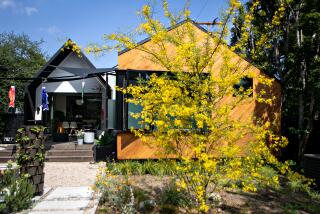‘Wave House’ architect translates nature’s forms into residential designs
- Share via
Consider the agitated envelope that sheathes Mario Romano’s latest Venice design: It resembles a bed sheet shaken out, rippled by invisible currents, and then frozen in midair.
Romano’s 5,700-square-foot Wave House is a riff on water and air — in short, architectural biomimicry. The five-bedroom, four-bathroom home is listed for $5.717 million by Halton Pardee + Partners.
“The collision of art, technology, nature and science — it’s an exciting intersection for me,” said Romano, who launched his Santa Monica-based design and build firm in 2002, since building 14 projects in Venice and Santa Monica.
Romano is an adherent of parametricism, a design style that eschews right angles, repetitive flatness, and what the designer-builder calls “authoritarian” box-like structures. Instead, nature’s intricate geometry is replicated — not the natural world’s forms per se (a wave, a field of clouds) — but the behavior that those forms exhibit.
Such post-postmodern architecture is ascendant and includes such iconic examples as Frank Gehry’s Walt Disney Concert Hall and the Broad museum, designed by Diller Scofidio + Renfro.
Romano’s goal is to scale such monumental designs down to residential size where “a continuity and fluidity — a feeling of no beginning and no end” can be more fully appreciated, he said.
Such circularity begins with more basic forms: machines powered by math.
To create the 300 sheets of joined white aluminum that envelop the Wave House, Romano, 48, employed computer numeric control technology. The behavior of nature’s random forms (such as wave patterns) are distilled into algorithms, or mathematical rule sets. Parameters are then tweaked to create novel forms within a computer-aided design application.
Those tailored forms are cut by Romano’s $100,000 computer numeric control machine, which he terms “a low-level robot, like a 3-D printer.” The strips are then affixed to a metal substructure. Romano continues the biomimicry theme on courtyard walls covered with overlapping DuPont Corian strips that resemble feathers.
Pitched at 30 degrees, the horizontal fins, as Romano calls them, help keep the house cooler and drier because the siding easily sheds water and heat, much like bird feathers.
“Nature does things so efficiently, so why not copy it?” said Romano, a design and construction autodidact who was born in Santa Monica and raised in Brentwood.
Beyond a nine-foot center-pivot front door built from skateboard decks (a riff on Venice beach culture), 10 walls are covered in textured Corian that mimic such non-repeating patterns as flocks of birds, palm fronds and the hides of giraffes and tortoises.
“The walls get charged by light that shifts throughout the day, carving shadows,” Romano said. “They’re very sensual — you want to touch them.”
It’s easy to see why Romano describes his homes as “performance-based.” Two other Romano homes under construction in Venice are equally theatrical: one enveloped with black aluminum fins pitched in vertical rows, the other clad in more than 1,000 pieces of brushed aluminum that cascade in ripples over the home’s roof and down the side.
Romano terms his protean design approach as a “breakout language,” and indeed, his tendentious homes are talked about, both with admiration and reserve.
“You’ll never find one house that everybody will love,” said listing agent Nancy Osborne of Halton Pardee + Partners. But they’ve been popular on the Westside, an area clustered with high-tech firms. “These buyers want to live in homes that reflect who they are. They want to live in art.”
MORE FROM HOT PROPERTY
View home takes in the hills of La Cañada Flintridge
Barry Bonds’ former mansion in Beverly Park fetches $26.5 million
Starship’s Mark Morgan blasts off from modern home above Zuma Beach
More to Read
Sign up for Essential California
The most important California stories and recommendations in your inbox every morning.
You may occasionally receive promotional content from the Los Angeles Times.




